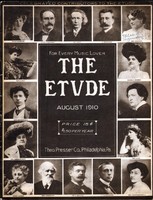It is doubtful if anything is seen more frequently upon programs of violin music just at present than the Humoresque, by Anton Dvorak. It is used in recitals by the world's greatest violinists, and never fails to make a telling hit with even the most uncultured audience.
A correspondent wishes to know the history of this charming bit of melody. It makes a story of great interest and shows how eager the world is for a new inspiration, which really rings true and comes straight from the heart. It is doubtful if Dvorak ever realized what a matchless gem he had produced, for he died, in 1904, before his Humoresque had achieved a world-wide popularity.
The piece is the seventh of a set of eight "Humoresken," written for piano solo, and published in two books in 1894. The works are as follows: No. 1, E flat minor; 2, B major; 3, A flat major; 4, F major; 5, A minor; 6, B major; 7, G flat major; 8, B flat minor. None of the pieces, except the now famous seventh in G flat major, attained any special note. Dvorak evidently intended the piece to be, as its name indicates, of a light, humorous character. The metronome mark was set for a quarter note=72, nearly double as fast as it is now played as a violin solo. As a piano solo and at a rapid tempo the composition failed at first to attain any great fame, and it was not until it was arranged for the violin and the great violinists began playing it that its supreme beauty was recognized by the musical world. It was apparent to violin soloists that, beautiful as the melody was at a rapid tempo, it was far more effective slower, and most of them made a dreamy adagio out of it, often playing it four in a bar instead of two as written. I know of very few instances in the history of music where such a striking change has been made in a composition by an eminent composer. The whole character of the piece has been changed, and it is certainly much more effective at a slow tempo. There are three fine arrangements of the work for violin and piano, one by August Wilhelmj, one by Fritz Kreisler, and one by Fabian Rehfeld. An extremely easy edition for the violin in the first position, which can be mastered by comparative beginners, has been brought out by E. Haddock. There are arrangements for the 'cello and piano, by Leo Schrattenholz; for the organ, by Edwin Lemare, and for small orchestra, by Adolph Schmid.
Frederick Stock, conductor of the Theo. Thomas Orchestra of Chicago, has made an effective arrangement for grand orchestra, and uses it with great success in his concerts. The Humoresque can also be obtained as a duet for the piano, for string quartet, and for violin, piano and cello. In some of these arrangements it has been transposed from the original key. The success it has attained shows how eagerly new works, no matter for what instrument they are written, are scanned in order to add a new gem to the stock of violin music.



